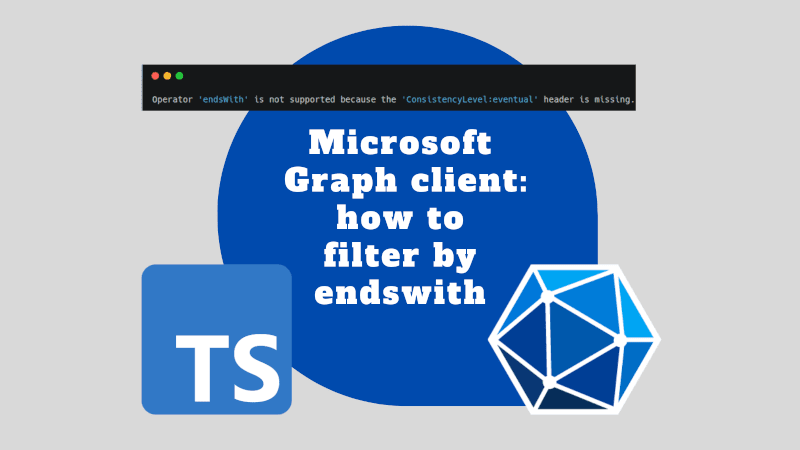Microsoft Graph client: how to filter by endswith
In this post we're going to look at filtering using an endswith filter with the Microsoft Graph client. This falls into the category of "Advanced query capabilities on Microsoft Entra ID objects" and I found tricky to get working.

Performing an endsWith or similar filter shouldn't be difficult. But the method of how to do so isn't obvious. If you've ever encountered a message like this:
Operator 'endsWith' is not supported because the 'ConsistencyLevel:eventual' header is missing. Refer to https://aka.ms/graph-docs/advanced-queries for more information
Then this blog post is for you.
Related posts
I've written before about the Microsoft Graph client, and how to use it with Azure AD groups. You can find those posts here:
- Azure AD Claims with Static Web Apps and Azure Functions
- Graph API: getting users Active Directory group names and ids with the C# SDK
Advanced query capabilities on Microsoft Entra ID objects
First let's quote from the documentation around advanced query capabilities on Microsoft Entra ID objects:
Microsoft Graph supports advanced query capabilities on various Microsoft Entra ID objects, also called directory objects, to help you efficiently access data. For example, the addition of not (
not), not equals (ne), and ends with (endsWith) operators on the$filterquery parameter.
Let's say we have a need for the endsWith operator or similar, for example: when querying for Entra ID / Azure AD groups. We may want to filter for groups that end with a certain string. And you can do that, but it does not work by default.
This is quite disappointing, and the documentation explains why this is the case:
The Microsoft Graph query engine uses an index store to fulfill query requests. To add support for additional query capabilities on some properties, those properties might be indexed in a separate store. This separate indexing improves query performance. However, these advanced query capabilities aren't available by default but, the requestor must set the
ConsistencyLevelheader to eventual and, except for$search, use the$countquery parameter. TheConsistencyLevelheader and$countare referred to as advanced query parameters.
I find this quite surprising. Essentially, the implementation of the endsWith and similar operators are bleeding through into the API design. This is quite clunky, and not something that I would expect from a modern API. It feels like a design decision that is more about performance than usability. Even if you do want to discourage the use of the endsWith operator, it would be nice to have a more user-friendly way of doing so. For example, you could have a separate endpoint for advanced queries, or simple query parameter that enables advanced queries without having to set headers and a seemingly arbitrary query parameter.
However, the good news is that it is possible to use the endsWith operator (and others like it) with the Microsoft Graph client. The bad news is the way you have to do it.
Failing to use the endsWith operator with the Microsoft Graph client
We'll make what we're looking into concrete in this post, by having a meaningful example of querying the Graph client. We'll query for Entra ID / Azure AD groups. First let's see what a broken example looks like:
import { Client, type PageCollection } from '@microsoft/microsoft-graph-client';
export async function getAzureADGroups(
graphClient: Client,
): Promise<PageCollection> {
return (await graphClient
.api('/groups')
.filter(`startsWith(displayName, 'startfilter-')`)
.filter(`endsWith(displayName, '-endfilter')`)
.select(['displayName', 'id'])
.get()) as PageCollection;
}
The above code is intended to query for Azure AD groups that start with startfilter- and end with -endfilter. However, it will fail with this error:
Operator 'endsWith' is not supported because the 'ConsistencyLevel:eventual' header is missing. Refer to https://aka.ms/graph-docs/advanced-queries for more information
This error is at least helpful in that it points you to the documentation. But it doesn't mention the $count query parameter. And it doesn't suggest how you might use the query parameter and header with the Microsoft Graph client.
Successfully using the endsWith operator with the Microsoft Graph client
To use the endsWith operator with the Microsoft Graph client, you need to set the ConsistencyLevel header to eventual and use the $count query parameter as you make your call.
I pieced together how to do this with the Microsoft Graph client based upon these two pieces of documentation:
- https://learn.microsoft.com/en-us/graph/sdks/create-requests?tabs=typescript#use-http-headers-to-control-request-behavior
- https://learn.microsoft.com/en-us/graph/sdks/create-requests?tabs=typescript#provide-custom-query-parameters
Based upon this, I was able to produce the following code:
import { Client, type PageCollection } from '@microsoft/microsoft-graph-client';
export async function getAzureADGroups(
graphClient: Client,
): Promise<PageCollection> {
return (await graphClient
.api('/groups')
.query({
$count: 'true',
})
.header('ConsistencyLevel', 'eventual')
.filter(`startsWith(displayName, 'startfilter-')`)
.filter(`endsWith(displayName, '-endfilter')`)
.select(['displayName', 'id'])
.get()) as PageCollection;
}
This code sets the ConsistencyLevel header to eventual and uses the $count query parameter. This allows you to use the endsWith operator in your query. It works as expected and returns the groups that start with startfilter- and end with -endfilter.
A complete example
To make this a complete example, let's look at how you might use this in a real application. We'll create a function that retrieves Azure AD groups using the Microsoft Graph client. This function will use the endsWith operator and the ConsistencyLevel header.
import { DefaultAzureCredential } from '@azure/identity';
import { Client, type PageCollection } from '@microsoft/microsoft-graph-client';
export interface AzureADGroup {
/** eg name-of-group */
displayName: string;
/** eg GUID-GUID-GUID-GUID-GUID */
id: string;
}
export async function getMyAzureADGroups(): Promise<AzureADGroup[]> {
return getAzureADGroupsImpl({
queryProvider: async (graphClient: Client) => {
return (await graphClient
.api('/me/memberOf')
.select(['displayName', 'id'])
.get()) as PageCollection;
},
});
}
export async function getAzureADGroups(): Promise<AzureADGroup[]> {
return getAzureADGroupsImpl({
queryProvider: async (graphClient: Client) => {
return (await graphClient
.api('/groups')
.query({
$count: 'true',
})
.header('ConsistencyLevel', 'eventual')
.filter(`startsWith(displayName, 'startfilter-')`)
.filter(`endsWith(displayName, '-endfilter')`)
.select(['displayName', 'id'])
.get()) as PageCollection;
},
});
}
async function getAzureADGroupsImpl({
queryProvider,
}: {
queryProvider: (graphClient: Client) => Promise<PageCollection>;
}): Promise<AzureADGroup[]> {
// Use DefaultAzureCredential to authenticate
const credential = new DefaultAzureCredential();
// Initialize the Graph client
const graphClient = Client.initWithMiddleware({
authProvider: {
getAccessToken: async () => {
const tokenResponse = await credential.getToken([
'https://graph.microsoft.com/.default',
]);
return tokenResponse.token;
},
},
});
const groups: AzureADGroup[] = [];
try {
let response = await queryProvider(graphClient);
while (response.value.length > 0) {
for (const group of response.value as AzureADGroup[]) {
// {
// '@odata.type': '#microsoft.graph.group',
// displayName: 'azure-our-engteam',
// id: 'GUID-GUID-GUID-GUID-GUID'
// }
groups.push(group);
}
if (response['@odata.nextLink']) {
response = (await graphClient
.api(response['@odata.nextLink'])
.get()) as PageCollection;
} else {
break;
}
}
return { data: groups };
} catch (err) {
const errorMessage = `Error listing Entra ID / Azure AD groups: ${err instanceof Error ? err.message : 'UNKNOWN'}`;
console.error(errorMessage);
throw new Error(errorMessage, { cause: err });
}
}
This code has an implementation method getAzureADGroupsImpl that takes a queryProvider function. This function is responsible for providing the query to the Microsoft Graph client. The getAzureADGroupsImpl function handles the pagination of the results. It uses the @odata.nextLink property to retrieve the next page of results until there are no more pages left.
The getAzureADGroups and getMyAzureADGroups functions call this getAzureADGroupsImpl function method with their respective queries.
The getMyAzureADGroups function queries for the groups that the signed-in user is a member of. It does not use the endsWith operator. It simply queries for all groups that the user is a member of. This will work just fine without the ConsistencyLevel header or the $count query parameter.
The getAzureADGroups function queries for all groups that start with startfilter- and end with -endfilter. It uses the endsWith operator and consequently needs the ConsistencyLevel header and the $count query parameter. If it doesn't have these, it will fail with the error we saw earlier.
This code is a complete example of how to use the Microsoft Graph client to query for Azure AD groups using the endsWith operator. It handles authentication, pagination, and error handling. You can use this code as a starting point for your own applications that need to query Azure AD groups using the Microsoft Graph client.
Conclusion
In this post, we looked at how to use the endsWith operator (and similar "advanced query" operators) with the Microsoft Graph client. We saw that it is possible to use advanced query operators with the Microsoft Graph client, but it requires setting the ConsistencyLevel header to eventual and using the $count query parameter.
